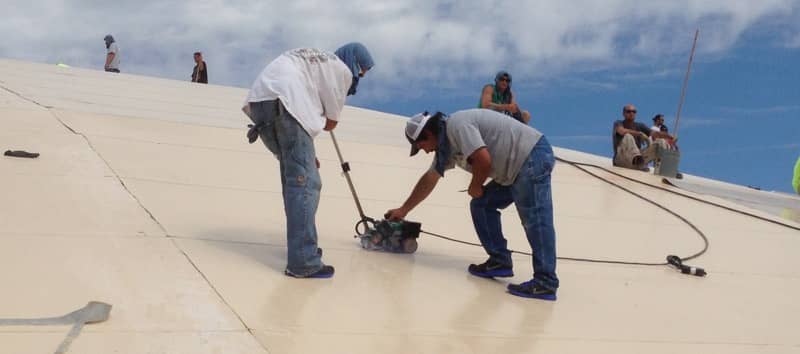 In order to determine the best attachment method for your roofing project, its crucial to first understand the positives and negatives of each method. Below, you will find an overview of five roofing system attachment methods and the associated pros and cons.
In order to determine the best attachment method for your roofing project, its crucial to first understand the positives and negatives of each method. Below, you will find an overview of five roofing system attachment methods and the associated pros and cons.
1. Ballast
Ballast, as defined by Wikipedia, is a “material that is used to provide stability to a vehicle or structure.” The use of ballast is the original method of waterproofing, and utilizes dirt, sod, palm leaves and other natural materials to shed water. These items, along with gravel and stones, are subsequently used to ballast rags, paper, felts and membranes on a roof.
Today’s ballast remains primarily gravel and stone, but also includes concrete and polymer paver blocks, garden roofs and other multi-purpose components.
Positive
- Non-penetrating
- Can be decorative
- Can be “green”
- Time tested
- Non-combustible (may exclude Garden Roofs)
Negative
- Wind scour
- Heavy
- Dirty
- Repairs are difficult
- Sharp corners and roof traffic can cause damage to the roof surface
Learn more about Ballast roofing systems here.
2. Mechanically Attached Roofing Systems
Simply stated, mechanical attachment refers to the use of galvanized steel, stainless steel, polymer, or aluminum nails or screws to attach the paper, felts, or membrane directly to or through the structural decking. A steel or plastic plate is used to distribute the strength of the fastener over a broader area.
Positive
- Easily engineered for higher uplifts
- Surface exposed to allow for ease of repair and cleaning
Negative
- Penetration of the structural component
- Potential for “flutter” in the roof system
Learn more about Mechanically Attached roofing systems here.
3. Adhered Roofing Systems
Adhered roofing systems use adhesives to “completely” bond the felt or membrane to suitable substrata which have been bonded or attached to the structural component. Adhesives are applied as either contact (single-side) or bonding (double-side) applications using water, solvent, urethane or asphaltic based compounds.
Positive
- May not require penetration of the structural component
- Flat, smooth appearance
Negative
- Vulnerable to “peel” during high winds
- Weather and applicator sensitive during application
Learn more about adhered roofing systems here.
4. Partially Adhered Roofing Systems.
Partially Adhered roofing systems use urethane adhesives in a ribbon attachment to membrane to suitable substrata which have been bonded or attached to the structural component.
Positive
- May not require penetration of the structural component
- Uses less adhesive than full coverage
Negative
- Vulnerable during high winds
- Weather and applicator sensitive during application
Learn more about Partially Adhered roofing systems here.
5. Induction Welded Roofing Systems
Induction Welded roofing systems are similar to mechanically attached application in that a nail, screw or fasteners and a coated metal plate are used to distribute the strength of the fastener over a broader area. This plate includes a coating to allow for the induction welding of the top surface of the plate to the bottom of the membrane.
Positive
- Easily engineered for higher uplifts
- Surface exposed to allow for ease of repair and cleaning
Negative
- Penetration of the structural component
- “Pillow-top” appearance
Learn more about Induction Welded roofing systems here.
Which roofing system do you prefer to specify/install? Share your thoughts in the comments.
-1.png?width=500&height=271&name=FiberTite_Only%20(500px%20wide)-1.png)


-1.png)